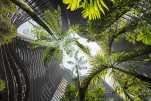New Jungle of Singapore

Tall Buildings magazine publishes the interview with Christoph Ingenhoven. The Head of German based studio Ingenhoven Architects founded his firm more than a decade ago and has already became notable for his ecologically oriented designs. As an international role model for living and working, Marina One makes an innovative contribution to the discourse on mega-cities, especially in tropical regions, which, in the context of increasing population and climate change, face enormous challenges. The high-density building complex with its mix of uses extends to over 400,000 square meters and, with its group of four high-rise buildings, defines the “Green Heart”—a public space extending over several stories. This three-dimensional green oasis reflects the diversity of tropical flora.
What is special about the city-state of Singapore?
It occupies a special position, both politically and geographically. First of all, it’s true that like other nations, Singapore is criticized for its concept of human rights. In 1965, Singapore was separated from Malaysia in a peaceful but non-mutual process.
Back then it was nothing like the attractive location it is today, but it was always an extremely important port – especially after the discovery of the sea route to Asia – and important strategically, and it was always interesting for me as the location of some of Joseph Conrad’s novels. Many people are actually drawn to Singapore when things get too hot for them elsewhere, when their freedom of speech has been restricted, etc. In this sense, Singapore has always been reliable. And I think it still is and has become even more so. Today Singapore has around six million inhabitants and it’s going to continue to grow.
But how? There’s no room.
Exactly. Growth is possible only through land reclamation because, of course, the space is extremely limited. They’ve been filling in land for decades and at a growing rate, above all in the bay and on the coast. They move their sea port – now the world’s second-largest and apparently also its second-fastest – from one place to another. Currently there are plans to move it again. They reroute a highway for a project – for ours, for example – they have no problem with that. Extreme pragmatism and efficiency prevail. But it’s related to the fact that Singapore is not a major city that grew slowly over centuries but was a comparatively small city that boomed.
Full content of this issue you can read here
The full version of the article can be read in our printed issue, also you can subscribe to the web-version of the magazine
 Materials provided by INGENHOVEN ARCHITECTS
Materials provided by INGENHOVEN ARCHITECTS


